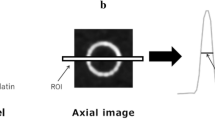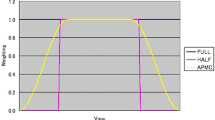Abstract
Dual-energy CT can be applied for bone elimination in cerebral CT angiography (CTA). The aim of this study was to compare the results of dual-energy direct bone removal CTA (DE-BR-CTA) with those of digital subtraction angiography (DSA). Twelve patients with intracranial aneurysms and/or ICA stenosis underwent a dual-source CT in dual-energy mode. Post-processing software selectively removed bone structures using the two energy data sets. Three-dimensional images with and without bone removal were reviewed and compared to DSA. Dual-energy bone removal was successful in all patients. For 10 patients, bone removal was good and CTA maximum-intensity projection (MIP) images could be used for vessel evaluation. For two patients, bone removal was moderate with some bone remnants, but this did not inhibit the three-dimensional visualization. Three aneurysms adjacent to the skull base were only partially visible in conventional CTA but were fully visible in DE-BR-CTA. In five patients with ICA stenosis, DE-BR-CTA revealed the stenotic lesions on the MIP images. The correlation between DSA and DE-BR-CTA was good (R 2=0.822), but DE-BR-CTA led to an overestimation of stenosis. DE-BR-CTA was able to eliminate bone structure using only a single CT data acquisition and is useful to evaluate intracranial aneurysms and stenosis.





Similar content being viewed by others
References
Agid R, Lee SK, Willinsky RA et al (2006) Acute subarachnoid hemorrhage: using 64-slice multidetector CT angiography to “triage” patients’ treatment. Neuroradiology 48(11):787–794
Hashimoto H, Iida J, Hironaka Y et al (2000) Use of spiral computerized tomography angiography in patients with subarachnoid hemorrhage in whom subtraction angiography did not reveal cerebral aneurysms. J Neurosurg 92(2):278–283
Hirai T, Korogi Y, Ono K et al (2001) Preoperative evaluation of intracranial aneurysms: usefulness of intraarterial 3D CT angiography and conventional angiography with a combined unit-initial experience. Radiology 220(2):499–505
Jayakrishnan VK, White PM, Aitken D et al (2003) Subtraction helical CT angiography of intra- and extracranial vessels: technical considerations and preliminary experience. AJNR Am J Neuroradiol 24(3):451–455
Lell M, Anders K, Klotz E et al (2006) Clinical evaluation of bone-subtraction CT angiography (BSCTA) in head and neck imaging. Eur Radiol 16(4):889–897
Sakamoto S, Kiura Y, Shibukawa M et al (2006) Subtracted 3D CT angiography for evaluation of internal carotid artery aneurysms: comparison with conventional digital subtraction angiography. AJNR Am J Neuroradiol 27(6):1332–1337
Tomandl BF, Hammen T, Klotz E et al (2006) Bone-subtraction CT angiography for the evaluation of intracranial aneurysms. AJNR Am J Neuroradiol 27(1):55–59
Venema HW, Hulsmans FJ, den Heeten GJ (2001) CT angiography of the circle of Willis and intracranial internal carotid arteries: maximum intensity projection with matched mask bone elimination-feasibility study. Radiology 218(3):893–898
Johnson TR, Krauss B, Sedlmair M et al (2007) Material differentiation by dual energy CT: initial experience. Eur Radiol 17(6):1510–1517
Samuels OB, Joseph GJ, Lynn MJ et al (2000) A standardized method for measuring intracranial arterial stenosis. AJNR Am J Neuroradiol 21(4):643–646
Chiro GD, Brooks RA, Kessler RM et al (1979) Tissue signatures with dual-energy computed tomography. Radiology 131(2):521–523
Millner MR, McDavid WD, Waggener RG et al (1979) Extraction of information from CT scans at different energies. Med Phys 6(1):70–71
Genant HK, Boyd D (1977) Quantitative bone mineral analysis using dual energy computed tomography. Invest Radiol 12(6):545–551
Laval-Jeantet AM, Cann CE, Roger B et al (1984) A postprocessing dual energy technique for vertebral CT densitometry. J Comput Assist Tomogr 8(6):1164–1167
Kelcz F, Joseph PM, Hilal SK (1979) Noise considerations in dual energy CT scanning. Med Phys 6(5):418–425
Primak AN, Fletcher JG, Vrtiska TJ et al (2007) Noninvasive differentiation of uric acid versus non-uric acid kidney stones using dual-energy CT. Acad Radiol 14(12):1441–1447
Scheffel H, Stolzmann P, Frauenfelder T et al (2007) Dual-energy contrast-enhanced computed tomography for the detection of urinary stone disease. Invest Radiol 42(12):823–829
Graser A, Johnson TR, Bader M et al (2008) Dual energy CT characterization of urinary calculi: initial in vitro and clinical experience. Invest Radiol 43(2):112–119
Sun C, Miao F, Wang XM et al (2008) An initial qualitative study of dual-energy CT in the knee ligaments. Surg Radiol Anat 30(5):443–447
Pozzi-Mucelli F, Bruni S, Doddi M et al (2007) Detection of intracranial aneurysms with 64 channel multidetector row computed tomography: comparison with digital subtraction angiography. Eur J Radiol 64(1):15–26
Gorzer H, Heimberger K, Schindler E (1994) Spiral CT angiography with digital subtraction of extra- and intracranial vessels. J Comput Assist Tomogr 18(5):839–841
Hoit DA, Malek AM (2006) Fusion of three-dimensional calcium rendering with rotational angiography to guide the treatment of a giant intracranial aneurysm: technical case report. Neurosurgery 58(1 Suppl):173–174
Nguyen-Huynh MN, Wintermark M, English J et al (2008) How accurate is CT angiography in evaluating intracranial atherosclerotic disease? Stroke 39(4):1184–1188
Bash S, Villablanca JP, Jahan R et al (2005) Intracranial vascular stenosis and occlusive disease: evaluation with CT angiography, MR angiography, and digital subtraction angiography. AJNR Am J Neuroradiol 26(5):1012–1021
Author information
Authors and Affiliations
Corresponding author
Rights and permissions
About this article
Cite this article
Watanabe, Y., Uotani, K., Nakazawa, T. et al. Dual-energy direct bone removal CT angiography for evaluation of intracranial aneurysm or stenosis: comparison with conventional digital subtraction angiography. Eur Radiol 19, 1019–1024 (2009). https://doi.org/10.1007/s00330-008-1213-5
Received:
Revised:
Accepted:
Published:
Issue Date:
DOI: https://doi.org/10.1007/s00330-008-1213-5




